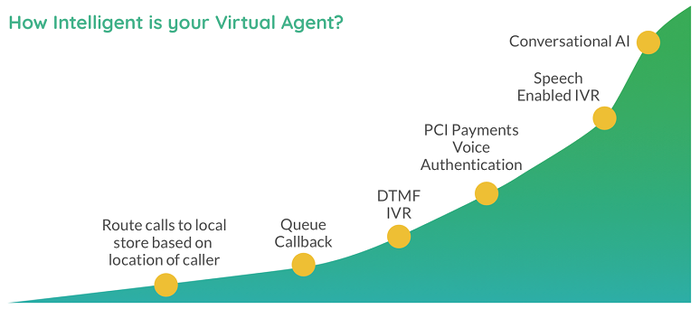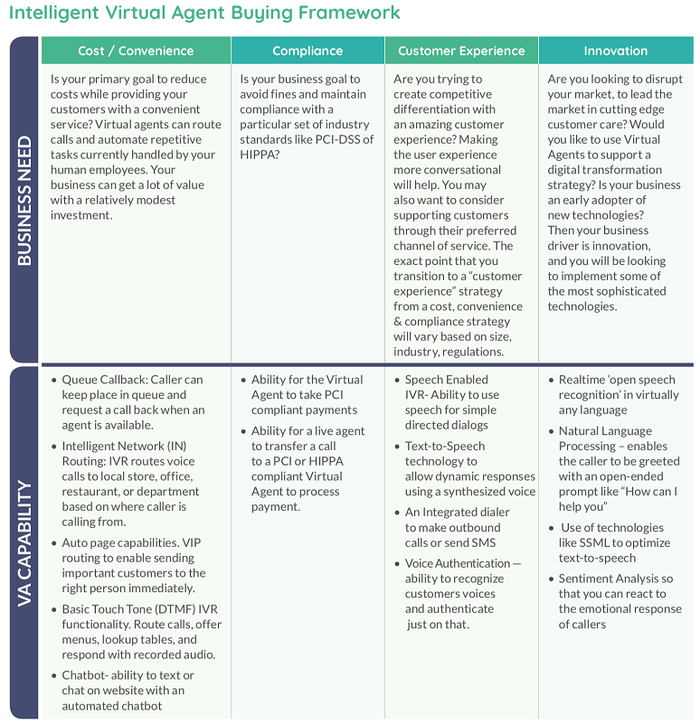How to Choose the Right Type of Virtual AgentHow to Choose the Right Type of Virtual Agent
Intelligent virtual agents can provide tremendous business value, but they're not all equal.
February 27, 2019

After more than 10 years of working with contact center and customer service software solutions, I recently started a new career as a consultant. One of my first projects was to develop a buyer’s guide for virtual agents. Having spent the last three years working on automated self-service applications, I was thrilled to undertake the project. I've seen first-hand how intelligent virtual agents can provide businesses with tremendous value and are poised for growing market adoption.
This post offers a summary of the guide. I’ve also included my decision framework that helps buyers select the right type of virtual agent based on business need. You can find the full guide here.
Virtual Agents
Virtual agents, also known as virtual customer assistants, are software programs that can emulate human customer service or sales personnel, often based on artificial intelligence (AI) platforms. Virtual agents use either a speech (spoken) or chat (written) interface to “talk” to customers. Virtual agents automate repetitive tasks and transactions like allowing a customer to check balances, pay bills, authorize a credit card, or schedule an appointment. This allows your most valuable asset -- your people -- to focus on solving more complicated problems, saving you money while improving your customer’s experience.
Major advancements in AI, speech recognition, and natural language processing have given organizations that need to automate self-service a giant leap forward. For the first time ever, companies of all sizes can now use virtual agents to reduce costs and improve the customer experience.
The Rise of Virtual Agents -- Why Now?
Virtual agents often work closely with your human employees, offloading repetitive tasks. The technology has been around for over a decade but is just now exploding. What’s driving the current popularity?
Rising Customer Expectations -- Today’s customers demand personalized answers fast, on demand, and delivered in a way that is most convenient to them. If you don’t meet their high expectations, they may turn to your competition that delivers a better experience.
Demand for Self-Service -- More and more, customers now prefer self-service; in fact, Gartner predicts that by 2020, customers will manage 85% of their relationships with enterprises without interacting with humans. While this may be an ambitious forecast, it highlights an important trend that will continue as the millennial generation’s buying power grows.
Technology Improvements and Growing Comfort with Conversational AI -- Consumers are now conversing daily with AI-based assistants, such as Amazon Alexa, Apple’s Siri, Microsoft Cortana, and Google Home. As they get comfortable with voice interfaces, they’re expecting to use similar technology in other areas. At the same time, AI technology and speech recognition capabilities are rapidly improving, leading to wider adoption of virtual agent technologies.
Massive Focus on Digital Transformation -- Startup companies are using new technology-centric business strategies to disrupt legacy markets. The taxi business is facing competition from Uber and Lyft, and brick-and-mortar retailers are under pressure from Amazon. Even banking is facing competition from new digital-first lenders. Almost every segment of the market is facing new competition, and companies are racing to develop new digital business models to defend their businesses. Improving automated self-service is a key pillar of many organizations’ strategies to improve the customer experience and build more direct relationships with customers.
Chatbots & Speech-Enabled IVR Unite
Two types of self-service technologies are merging to become what we now call intelligent virtual agents.
The first started by offering self-service to customers over the phone in the form of IVR, eventually adding on basic speech recognition. The second, now called chatbots, later emerged to provide self-service through chat or SMS. Both types have become more intelligent over time, incorporating technologies like natural language processing (NLP) and machine learning (ML) to improve the quality and scope of service. We've now reached the point where an automated service solution can be designed once to support both voice and text-based channels of service, further reducing deployment costs.
Click below to Page 2: What Can a Virtual Agent Actually Do for Your Business?
What Can a Virtual Agent Actually Do for Your Business?
Every organization has different needs when architecting an automated self-service or virtual agent strategy. Companies of all sizes -- even ones that don’t have traditional contact centers -- can benefit from intelligent virtual agents. Depending on your specific type of business and tasks performed, a virtual agent can help reduce costs, increase customer satisfaction, and improve productivity.
Smaller Organizations -- If you have a small or local business, you may not have a contact center in the traditional sense, but you do have employees whose job entails varying degrees of customer contact. Your volume of customer interactions may not be as high as a company that requires a contact center; however, because the technology is so cost effective, a virtual agent can help you reduce costs and improve your customer’s experience in a number of ways. You can:
Enable callers to request call-backs instead of waiting on hold
Offer automated appointment scheduling and reminders
Offer to send directions via SMS
Replace frustrating touchtone menus for incoming calls with natural conversations
Offer automated order lookups
Collect payments for services -- and be PCI-compliant
Offer self-service support outside of standard business hours
Mid-Size and Large Enterprises -- Your organization has a traditional contact center for customer service and/or sales. Your contact center may range in size from small (1-100 agents), mid-size (100-500 agents), large (500+ agents) to global (multiple locations around the world, typically 1,000+ agents). Virtual agents can play a key role in cost reduction, compliance, and digital transformation for your organization. They can:
Augment contact center agents with easy-to-use, conversational self-service across multiple channels
Reduce customer service costs by offloading easy repetitive tasks currently handled by agents
Provide VIP service to your most important customers by routing them immediately to someone who can help them
Extend service business hours
Handle growing volumes of interactions, support peak seasonal transactions, new services, and products without adding employees
Ensure compliance across industries -- including automated solutions for PCI payments, HIPPA, and TCPA
Offer more complex, transactional self-service applications like making hotel reservations, booking travel, or applying for a loan
What Makes a Virtual Agent Intelligent?
Not all virtual agents are created equal; some are simple scripts with little intelligence built in. Sometimes that’s all you need. But to create a virtual agent that will grow with your business, you need to make sure you choose one that can get smarter over time as your business needs evolve. You need an intelligent virtual agent, or IVA. What makes a virtual agent intelligent? Virtual agents are intelligent when they:
Have skills -- For example, they can understand human speech in more than 100 languages and can respond using text-to-speech (TTS) that is almost indistinguishable from a human agent.
Can automate things -- They can perform all kinds of tasks to care for customers. They can authenticate callers with voice biometrics, make appointments, reset passwords, look up orders, survey customers, and answer all kinds of questions -- over the phone, Web, or SMS.
Can have different types of conversations -- Whether over the phone or through a text-based interaction, virtual agents can use multiple approaches to converse with a customer, from basic to sophisticated.
DTMF -- “Press 1 for sales, 2 for service.”
Directed Dialog -- “Would you like to purchase, please say yes or no.”
Mixed Interaction -- “I’d like to fly from Austin to Boston, next Wednesday at 5 p.m.”
NLP -- Ability to have a natural language, free-flowing conversation via phone
Are self-learning -- They can use machine learning to understand the various ways your customers ask for things. Individuals will ask for the same thing in different ways. For example, if the virtual agent is programmed to understand "I need to fix my car," over time it can learn the many different ways this might be asked -- i.e., "my car needs to get fixed," "my car is broken down," or "my car needs help."
Click below to Page 3: Buying Framework and Decision Factors
Intelligent Virtual Agent Buying Framework
Now that you know that virtual agents can have varying levels of intelligence, how do you choose the right type for your business?

This framework is a tool to help you assess where your business should fall on the spectrum of virtual agent capabilities -- and where you would eventually like to go, depending on your business drivers. By matching up your business needs with the relevant level of virtual agent intelligence needed to achieve your goals, you’ll have a solid framework to make a purchase decision on what level of virtual agent technologies to implement. Remember that virtual agents are highly customizable, allowing you to combine almost any skills with a set of tasks that can be automated. This model is intended to provide you with some examples to get you started.
Business Need -- Determine what you’re currently looking to achieve with a virtual agent; what’s your business need now? What are your business goals in the future? Are they different than today’s? A broad range of agent skills and capabilities fall under the intelligent virtual agent umbrella; some companies will want to implement the entire spectrum over time, but for others, the full set of capabilities won’t ever be necessary or desirable.
Virtual Agent Capabilities -- Match those business needs up with the virtual agent skills to help you determine the most relevant out-of-the-box virtual agent technologies for your company to consider. Repeat this process if your future business goals for your virtual agent evolve and grow over time -- for example, if you’re looking to cut costs today with a virtual agent, but anticipate growing the tool to delight your customers in the future.

Decision Criteria Checklist
An intelligent virtual agent is built on an IVA platform, but not all IVA platforms are the same. The first few generations of AI-based virtual agent platforms are still around, delivering a “black box” that requires many, many hours of customized development, professional services, and data scientist resources for tweaking and maintaining complex AI models and conversational dialog flows. This has resulted in extended deployment times and inflated costs for companies that choose the wrong vendor.
The new generation of purpose-built, SaaS-based intelligent virtual agents offers a much better, more cost-effective and easier way to deploy virtual agents. Here’s what to look for when comparing intelligent virtual agent solutions:
Purpose-Built -- for customer care or sales
Omnichannel -- speech (voice) and chat (written text) interfaces, across a variety of customer touchpoints and channels, such as phone, websites, and messaging platforms
Build Once, Deploy Anywhere -- Ability to build the virtual agent once, then deploy to any channel with minimal changes
Speech Recognition and Text-to-Speech -- with easy access to hundreds of languages
Advanced NLP -- with integration to services like Google Dialogflow and IBM Watson
Technology Neutral -- your virtual agent solution should bring together access to all relevant vendors’ AI and speech tools with an easy-to-use visual front end
Future-Proofed Technology Access -- does the solution give you timely access to new innovations in speech, conversational AI, and natural language as they’re adopted in the market?
No Developers or Data Scientists Required -- Does the solution provide drag-and-drop, easy-to-use visual tools to create new tasks for your virtual agent? Can you build a virtual agent without coding? Even non-techies should be able to build new virtual agent tasks in minutes after minimal training
Pre-Built, Re-usable Task Library -- so you don’t start from scratch
Deploy and Build New Tasks in Minutes -- not weeks, months… or years! If you want to add new tasks such as appointment confirmations, bill payments, or account lookups, you should be able to build them quickly.
Easy Integration to Enterprise Systems -- ERP, billing, CRM, etc. Can you quickly look up a customers’ information and personalize the response as needed?
Enterprise Ready -- is the solution scalable to hundreds of thousands or millions of interactions? Does it provide security and authentication capabilities? Is it reliable?
Conclusion
Virtual agents are rapidly coming of age; picking the right one can save you time, money, and improve your relationship with your customers. To learn more about how intelligent virtual agents can benefit your particular business you might also want to take a look at this helpful guide.
About the Author
You May Also Like



